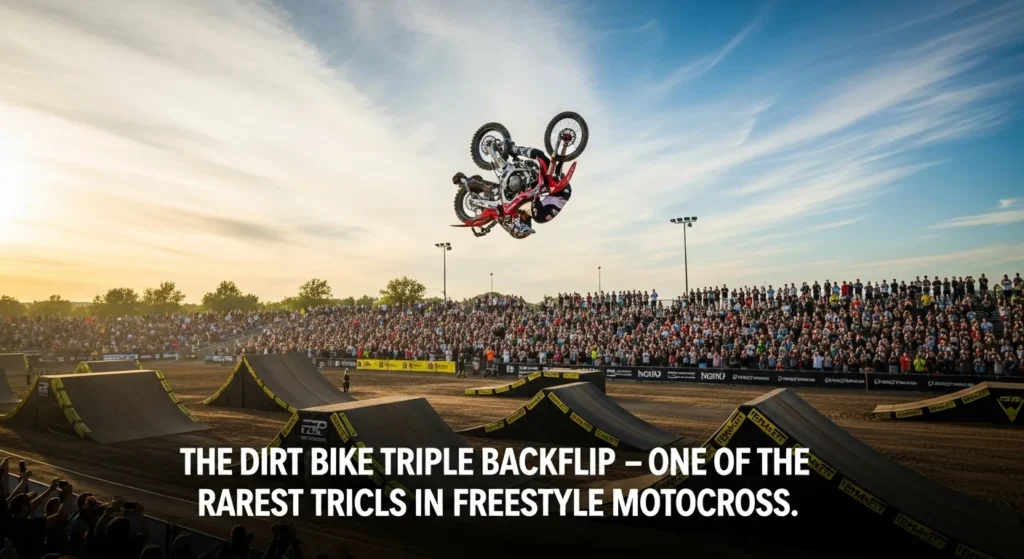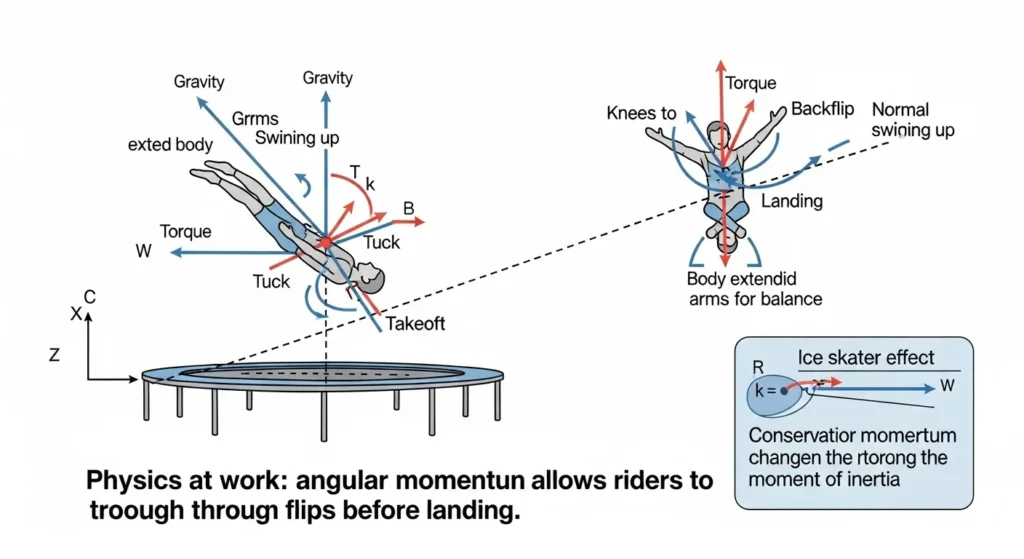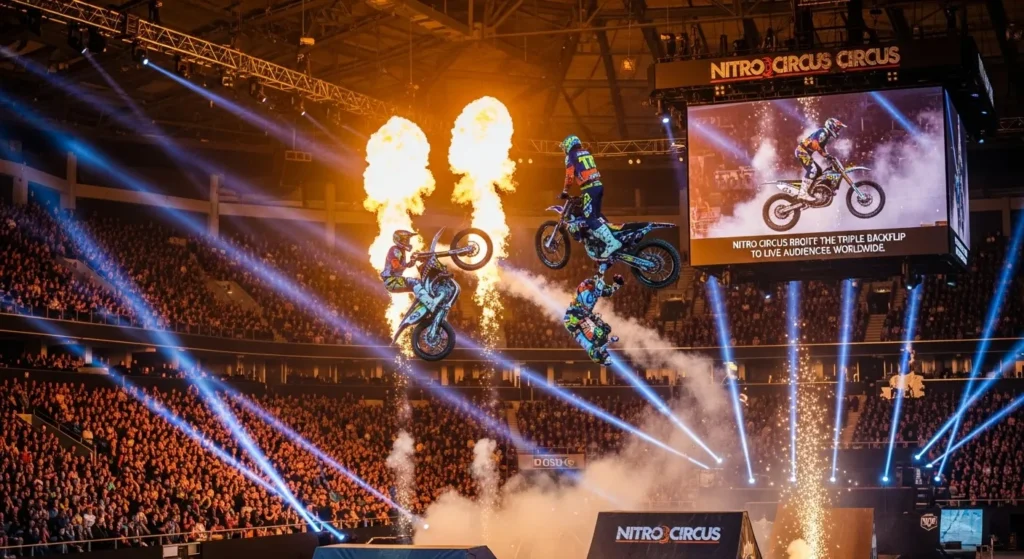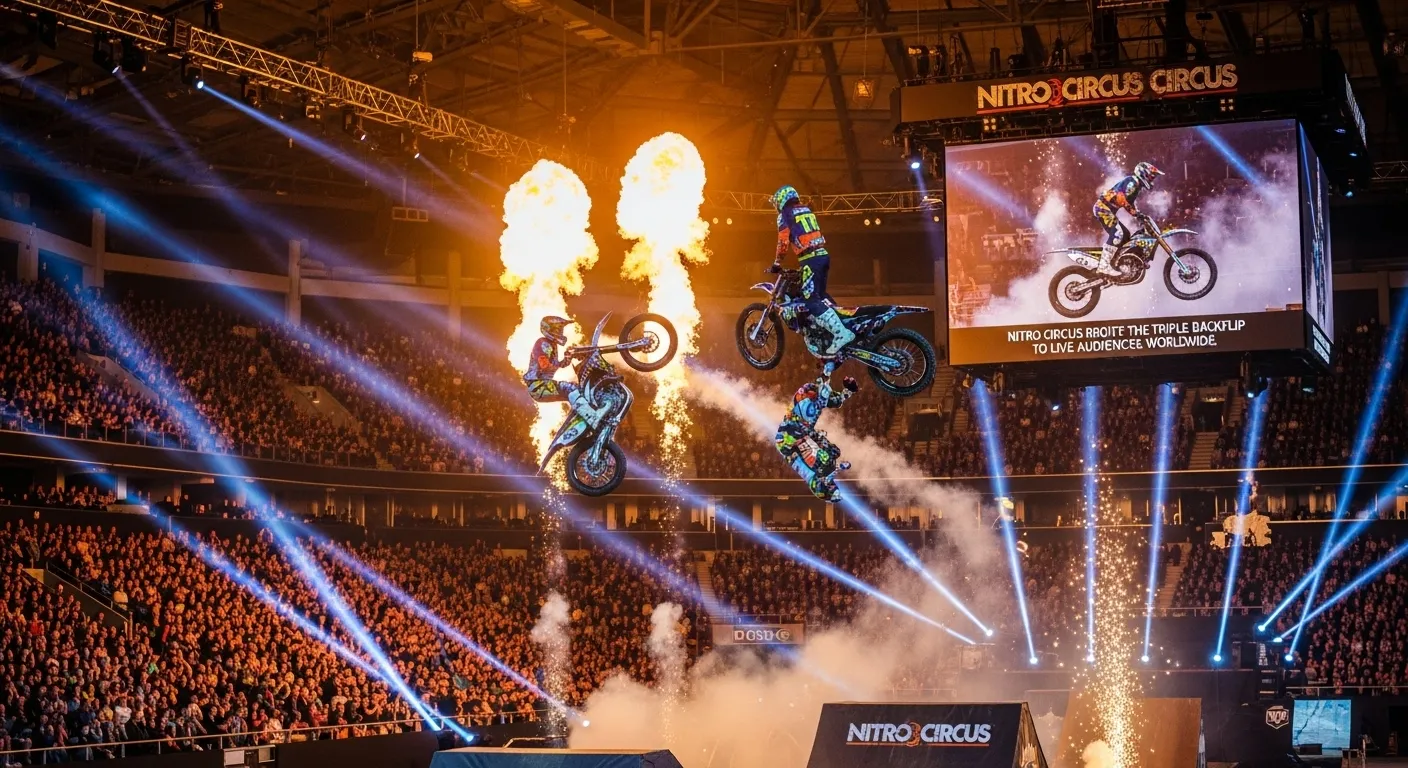Last updated on August 24th, 2025 at 09:16 am
The dirt bike triple backflip has always been the holy grail of freestyle motocross (FMX), so it was only natural that the discipline was tested to its enviable limit. The name itself explains the trick as a rider puts his bike in a massive ramp and rotates it three times in a backward direction before safely landing on two-wheels. It is a trick which requires extreme athletics, physics and nerves of nerves.
Even one backflip was thought to be exceedingly difficult in years. Then there was the two and finally, the three a feat which requires not only speed but also the highest degree of accuracy. It takes years of acclimatization to even attempt, specialized ramps and a care-free mind. The triple backflip is not mere trick project, it is a record mark in the history of FMX that changed the standards of human ability performance on a motor bike.

History of Backflips in Freestyle Motocross
The Impossible Dream
Flipping a dirt bike backward in those early days of freestyle motocross was seen as crazy perhaps even suicidal. Many of the Riders and fans perceived that the weight of the bike and its momentum could not allow the bike to turn completely without crashing. Even backflips were unheard of until finally overcome by FMX tricks of whips, nac-nacs and jumps variants.
The First Successful Backflip
This has all changed in 2002 when dirt-bike rider Carey Hart shocked the world by performing the first-ever backflip the dirt bike on the Gravity Games. It was proved that the trick could be done, though he crashed on landing. In 2002, shortly after, Mike Metzger performed a backflip in competition, the era of the backflip era in FMX officially had begun.
From One to Two Flips
When the door was opened, progression was rapid. Riders started to perfect the single backflip, and would add heel clickers, no-handers and Superman flips. Then in 2006, Australian rider Cam Sinclair and American Scott Murray began working on the double backflip. The first backflip was a double backflip by Travis Pastrana at the 2006 X Games and solidified his claim of originator of FMX advancement.
Setting the Stage for the Triple
With the single and double mastered, the sport naturally set its eyes on the triple. But the gap between double and triple was massive. It required bigger ramps, higher speeds, and flawless physics. For nearly a decade, the triple backflip remained a myth — until one fearless rider made history.
The First Triple Backflip: Josh Sheehan Makes History
Building the Dream Ramp
In the early 2010s there was much talk in the FMX world: Is it possible to get a triple backflip? The physics itself was the principal issue: a rider required sufficient altitude, distance, and the rate of rotation to perform three full flips. This was not adequate in normal ramps.
In a bid to accomplish the trick, Australian rider Josh Sheehan and support team Travis Pastrana at his training facility, Pastranaland in Maryland USA built a sixty-foot high take off ramp. This mega-ramp is one that has never been used in FMX.
The Attempt
On April 28, 2015, Sheehan was positioned his dirt bike, shot the throttle and rode it at the ramp at almost 60 miles an hour. With crowds of friends, film crew and fellow riders looking on in silence, Sheehan scattered as he skyrocketed upwards. The bicycle was turning over now at great speed –one-two-three and a third. Sheehan spotted his landing and with all odds against him landed perfectly. The crowd went wild and history was created in FMX.
Why It Was Revolutionary
Sheehan not only made a big stunt, but he took a giant leap in progressing the realm of action sports. There is no other rider that has ever tried the stunt, not to mention landing the trick. The successful landing immediately placed Sheehan in the position of FMX legends. It also showed how the sport moved along the postulates of the time: impossible to inevitable through the application of sufficient innovation, courage and preparation.

The Physics & Science Behind the Triple Backflip
Speed and Takeoff
The triple backflip is nothing but a war with the laws of gravitation and time. When a rider wants to do three complete rotations, he/she must have sufficient speed to cover some distance in front of him and as well as gain a height. The record-setting run-up that Sheehan attempted is nearly 60 mph (96 km/h) with an extremely steep angle of a specially-designed ramp. This installation provided optimum airtime rotation.
Rotation and Angular Momentum
Once airborne, the trick relies on angular momentum — the physics principle that keeps an object spinning once it starts. Riders tuck their bodies in and keep the bike compact to spin faster, much like a figure skater pulling in their arms. Even a slight hesitation in body movement can slow rotation and cause under-rotation, leading to a dangerous crash.
Precision Landing
Getting a triple backflip is all control more than it’s all concerning height. Riders, on completing the last rotation must “spot” the ground and control the throttle to balance the bike. Too much spin has you higher than you want to be with too much power, whereas do you find too little and you will come in short. The lines are hair-thin — sometimes a matter of less than a second below or above yields victory or catastrophe.

Step 1: Physical Conditioning
To ride on a ramp, an FMX athlete has to have the best strength, balance and stamina. Strength to maintain core stability and power generation through the legs are essential to maintain control when just off the ground and cardiovascular fitness will enable the rider to continue repeatedly high-intensity practice. Many pros workout as gymnasts and as mixed martial artists, combining heavy weights with flexibility training and maths to reaction drills.
Step 2: Mental Preparation
Strategies to control fear are quite relevant as physical competence When one tries to perform a triple backflip, there is always the threat of the deceptive danger of serious injury. Cyclers apply the visualization technique, meditation and gradual confidence application in order to remain calm in high stakes. This is how Josh Sheehan once stated, You have to believe that you can do it to be able to land it.
Step 3: Foam Pits and Airbags
No rider is straight to dirt. They do not do it with real snow, instead they train rotations into foam pits or really huge airbags to master timing and body positioning. These tools enable hundreds of attempts with lesser risk and enable riders to find perfected their moves before trying it on a real landing.
Step 4: Specialized Ramps
Triple backflips require a mega ramp that is built specially with greater height and an extended landing area. These ramps are finely calculated in terms of angle, which provides some time in the air to make three nice rotations, as well as reduction of the impact forces on landing.
Step 5: The Final Attempt
Students then graduate to dirt, following months of training. To achieve a successful synchronization every detail is needed, such as speed, throttle, posture, ramp angle. The margin of error is so tight that only a few riders have the world over taken the plunge to even attempt.
A Rare Sight in Competitions
Unlike single or double backflips, the triple is so technically demanding that it’s almost never seen in regular freestyle motocross competitions. The trick requires a custom ramp setup and massive safety precautions, making it impractical for standard arenas. That said, when it does appear, it instantly becomes the headline moment of the event.
Landmark Performances
The trick has been performed by Josh Sheehan prior to his 2015 triple at Pastranaland, after which the trick was seen in Nitro Circus Live events, an international live tour involving the sport of FMX. Through these shows, people around the world got the opportunity to see the move first hand. More recent, more younger riders have tried and demonstrated variations of the triple but the triple is still considered one of the rarest stunts in competitive FMX.
Media Impact
Less than 24-hours later, the success of Sheehan s triple backflip had become viral with millions of clicks on YouTube and other sports channels across the world. It has been replayed on ESPN, and has been the subject of action sports documentaries and an icon in extreme sports history. To this day, the landing clips reemerge on the social media reminding the fans of the day when the boundaries of the FMX were broken.

Pushing Beyond the Triple
In action sports, progression never stops. Just as the single backflip led to doubles and eventually the triple, many fans and riders now wonder: Is a quadruple backflip possible? On paper, physics doesn’t rule it out — but it would demand an even larger ramp, higher speeds, and near-perfect execution.
The Challenges Ahead
The main barriers are safety and practicality. A quadruple flip would likely require ramps so massive that few venues could host them. The risks of under-rotation or miscalculation also increase dramatically with every added flip, making it one of the most dangerous feats ever attempted.
What the Future Holds
Nevertheless, FMX has never been about doing the impossible. With the help of technology that leads to safer landing gear, larger ramps, and safer training equipment, the dream of quadruple backfacip will one day be removed out of the myth realm and in to the possibility realm. When (and hopefully it will), it will also change the history of freestyle motocross once more.

1. What exactly is a dirt bike triple backflip?
It is a FMX maneuver in which the rider jumps a large ramp, performs a full 360 degree backwards rotation of the body, and lands on only two wheels. It is an extremely difficult trick to leave a small number of riders who have even attempted it and even landed it.
2. Who landed the first triple backflip on a dirt bike?
A history was made on April 28, 2015, when Australian rider Josh Sheehan put the first rail to the down rail in Travis Pastrana’s Pastranaland compound in Maryland, USA. His first ever stadium screw landing, a most epic moment in FMX history.
3. How dangerous is the triple backflip?
Extremely. Riders are traveling around 60 mph and rotating a 200-pound dirt bike three times in the air. A mistake of even half a second could mean a life-threatening crash.
4. Can anyone train to do a triple backflip?
Realistically, no. It requires years of pro FMX, special ramps and a foam pit or airbags. It takes professional riders months or even years to get up a one of these on dirt.
5. How high does a rider go during the trick?
On Sheehan’s record-setting jump, the ramp sent him over 60 feet into the air, giving just enough time to rotate three times before landing.
6. Has anyone else landed a triple backflip since Sheehan?
A few riders have attempted it at shows or exhibitions, but the trick is still considered so dangerous and specialized that it remains incredibly rare.
7. Why don’t we see triple backflips in every competition?
Most arenas simply don’t have the space for the giant ramps and landing zones required. Plus, organizers weigh the risk factor — and a triple carries far more risk than reward in a standard contest.
8. Could we ever see a quadruple backflip?
Possibly. It is not impossible with the perfect ramp and technology. However, as it stands, it is just a fantasy yet because of safety issues.
9. How did fans react to the first triple backflip?
When Sheehan landed it, the video went viral within hours. Fans called it “the moon landing of FMX” and it was replayed on ESPN, YouTube, and extreme sports shows worldwide.
10. What does the triple backflip mean for the future of FMX?
It reveals that nothing is impossible in action sports. And with every new generation of riders, things continue to get edged closer and closer to the edge and the triple backflip is just that.
